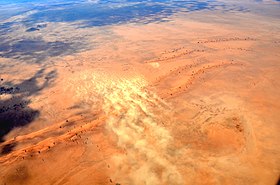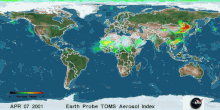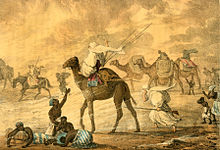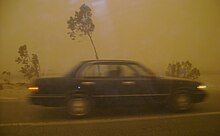Dust storm

| Dust storm | |
|---|---|
 A sandstorm approaching Al Asad April 27, 2005. | |
| Effect | May cause coughing and spread dust. |
| Part of a series on |
| Weather |
|---|
|
|
A dust storm, also called a sandstorm, is a meteorological phenomenon common in arid and semi-arid regions.[1] Dust storms arise when a gust front or other strong wind blows loose sand and dirt from a dry surface. Fine particles are transported by saltation and suspension, a process that moves soil from one place and deposits it in another.
The arid regions of North Africa, the Middle East, Central Asia and China are the main terrestrial sources of airborne dust. It has been argued that[2][unreliable source?] poor management of Earth's drylands, such as neglecting the fallow system, are increasing the size and frequency of dust storms from desert margins and changing both the local and global climate, as well as impacting local economies.[3]
The term sandstorm is used most often in the context of desert dust storms, especially in the Sahara Desert, or places where sand is a more prevalent soil type than dirt or rock, when, in addition to fine particles obscuring visibility, a considerable amount of larger sand particles are blown closer to the surface. The term dust storm is more likely to be used when finer particles are blown long distances, especially when the dust storm affects urban areas.
Causes[edit]

As the force of dust passing over loosely held particles increases, particles of sand first start to vibrate, then to move across the surface in a process called saltation. As they repeatedly strike the ground, they loosen and break off smaller particles of dust which then begin to travel in suspension. At wind speeds above that which causes the smallest to suspend, there will be a population of dust grains moving by a range of mechanisms: suspension, saltation and creep.[3]
A study from 2008 finds that the initial saltation of sand particles induces a static electric field by friction. Saltating sand acquires a negative charge relative to the ground which in turn loosens more sand particles which then begin saltating. This process has been found to double the number of particles predicted by previous theories.[4]
Particles become loosely held mainly due to a prolonged drought or arid conditions, and high wind speeds. Gust fronts may be produced by the outflow of rain-cooled air from an intense thunderstorm. Or, the wind gusts may be produced by a dry cold front: that is, a cold front that is moving into a dry air mass and is producing no precipitation—the type of dust storm which was common during the Dust Bowl years in the U.S. Following the passage of a dry cold front, convective instability resulting from cooler air riding over heated ground can maintain the dust storm initiated at the front.
In desert areas, dust and sand storms are most commonly caused by either thunderstorm outflows, or by strong pressure gradients which cause an increase in wind velocity over a wide area. The vertical extent of the dust or sand that is raised is largely determined by the stability of the atmosphere above the ground as well as by the weight of the particulates. In some cases, dust and sand may be confined to a relatively-shallow layer by a low-lying temperature inversion. In other instances, dust (but not sand) may be lifted as high as 6,000 m (20,000 ft). Dust storms are a major health hazard.
Drought and wind contribute to the emergence of dust storms, as do poor farming and grazing practices by exposing the dust and sand to the wind. Wildfires can lead to dust storms as well.[5]
One poor farming practice which contributes to dust storms is dryland farming. Particularly poor dryland farming techniques are intensive tillage or not having established crops or cover crops when storms strike at particularly vulnerable times prior to revegetation.[6] In a semi-arid climate, these practices increase susceptibility to dust storms. However, soil conservation practices may be implemented to control wind erosion.
Physical and environmental effects[edit]

A sandstorm can transport and carry large volumes of sand unexpectedly. Dust storms can carry large amounts of dust, with the leading edge being composed of a wall of thick dust as much as 1.6 km (5,200 ft) high. Dust and sand storms which come off the Sahara Desert are locally known as a simoom or simoon (sîmūm, sîmūn). The haboob (həbūb) is a sandstorm prevalent in the region of Sudan around Khartoum, with occurrences being most common in the summer.
The Sahara desert is a key source of dust storms, particularly the Bodélé Depression[7] and an area covering the confluence of Mauritania, Mali, and Algeria.[8] Sahara dust is frequently emitted into the Mediterranean atmosphere and transported by the winds sometimes as far north as central Europe and Great Britain.[9]
Saharan dust storms have increased approximately 10-fold during the half-century since the 1950s, causing topsoil loss in Niger, Chad, northern Nigeria, and Burkina Faso.[10] In Mauritania there were just two dust storms a year in the early 1960s; there are about 80 a year since 2007, according to English geographer Andrew Goudie, professor at the University of Oxford.[11][12] Levels of Saharan dust coming off the east coast of Africa in June 2007 were five times those observed in June 2006, and were the highest observed since at least 1999, which may have cooled Atlantic waters enough to slightly reduce hurricane activity in late 2007.[13][14]

Dust storms have also been shown to increase the spread of disease across the globe.[15] Bacteria and fungus spores in the ground are blown into the atmosphere by the storms with the minute particles and interact with urban air pollution.[16]
Short-term effects of exposure to desert dust include immediate increased symptoms and worsening of the lung function in individuals with asthma,[17][18] increased mortality and morbidity from long-transported dust from both Saharan[19] and Asian dust storms[20] suggesting that long-transported dust storm particles adversely affects the circulatory system. Dust pneumonia is the result of large amounts of dust being inhaled.
Prolonged and unprotected exposure of the respiratory system in a dust storm can also cause silicosis,[21] which, if left untreated, will lead to asphyxiation; silicosis is an incurable condition that may also lead to lung cancer. There is also the danger of keratoconjunctivitis sicca ("dry eyes") which, in severe cases without immediate and proper treatment, can lead to blindness.[citation needed]
Economic impact[edit]
Dust storms cause soil loss from the drylands, and worse, they preferentially remove organic matter and the nutrient-rich lightest particles, thereby reducing agricultural productivity. Also, the abrasive effect of the storm damages young crop plants. Dust storms also reduce visibility, affecting aircraft and road transportation.[This paragraph needs citation(s)]

Dust can also have beneficial effects where it deposits: Central and South American rainforests get significant quantities of mineral nutrients from the Sahara;[22][23] iron-poor ocean regions get iron; and dust in Hawaii increases plantain growth. In northern China as well as the mid-western U.S., ancient dust storm deposits known as loess are highly fertile soils, but they are also a significant source of contemporary dust storms when soil-securing vegetation is disturbed.[This paragraph needs citation(s)]
Iranian cities existence are challenged by dust storms.[24]
On Mars[edit]

Dust storms are not limited to Earth and have also been known to form on Mars.[25] These dust storms can extend over larger areas than those on Earth, sometimes encircling the planet, with wind speeds as high as 25 m/s (60 mph). However, given Mars' much lower atmospheric pressure (roughly 1% that of Earth's), the intensity of Mars storms could never reach the kind of hurricane-force winds that are experienced on Earth.[26] Martian dust storms are formed when solar heating warms the Martian atmosphere and causes the air to move, lifting dust off the ground. The chance for storms is increased when there are great temperature variations like those seen at the equator during the Martian summer.[27]
See also[edit]
- Coccidioidomycosis
- Dry line
- Dust storm warning
- Haboob
- Iberulites
- List of dust storms
- Mineral dust
- Saharan Air Layer
- Shamal (wind)
- Sirocco
References[edit]
- ^ "Airborne Dust: A Hazard to Human Health, Environment and Society". WMO - Bulletin: Vol 64 (2) - 2015. 2022. Archived from the original on December 18, 2023.
- ^ Eslamian, Saeid; Eslamian, Faezeh (2017). Handbook of Drought and Water Scarcity: Management of Drought and Water Scarcity. CRC Press. ISBN 978-1-351-85113-8. Retrieved 4 December 2017.
- ^ a b Squires, Victor R. "Physics, Mechanics and Processes of Dust and Sandstorms" (PDF). Adelaide University, Australia. Archived (PDF) from the original on 2015-06-05. Retrieved 2007-07-29.
- ^ "Electric Sand Findings, University of Michigan Jan. 6, 2008". Eurekalert.org. 2008-01-07. Archived from the original on 2016-05-20. Retrieved 2016-12-04.
- ^ "Wildfires often lead to dust storms – and they're getting bigger". 18 November 2022.
- ^ "Dust Storms Chapter" (PDF). Emergency Management Plan. State of Oregon. Archived from the original (PDF) on 2013-10-21.
- ^ Koren, Ilan; Kaufman, Yoram J; Washington, Richard; Todd, Martin C; Rudich, Yinon; Martins, J Vanderlei; Rosenfeld, Daniel (2006). "The Bodélé depression: A single spot in the Sahara that provides most of the mineral dust to the Amazon forest". Environmental Research Letters. 1 (1): 014005. Bibcode:2006ERL.....1a4005K. doi:10.1088/1748-9326/1/1/014005.
- ^ Middleton, N. J.; Goudie, A. S. (2001). "Saharan dust: Sources and trajectories". Transactions of the Institute of British Geographers. 26 (2): 165. doi:10.1111/1475-5661.00013. JSTOR 3650666.
- ^ Pericleous, Koulis; et al. (2006). "Airborne Transport of Saharan Dust to the Mediterranean and to the Atlantic". Environmental Modelling and Simulation. EMS-2006: 54–59. ISBN 9780889866171.
- ^ "Global Assessment of Sand and Dust Storms" (PDF). The United Nations Environment Programme. 2022.
- ^ Brown, Lester R. (June 27, 2007) Environment: Around the Globe, Farmers Losing Ground Archived 2016-12-20 at the Wayback Machine. ipsnews.net
- ^ Brown, Lester R. "Losing Soil". Archived from the original on 2007-06-29. Retrieved 2007-06-29.
- ^ Loney, Jim (August 9, 2007) Scientists examine African dust link to hurricanes Archived 2016-12-20 at the Wayback Machine. Reuters
- ^ "NASA: Saharan Dust Has Chilling Effect on North Atlantic". Nasa.gov. December 2007. Archived from the original on 2017-05-31. Retrieved 2016-12-04.
- ^ Griffin, D. W. (2007). "Atmospheric Movement of Microorganisms in Clouds of Desert Dust and Implications for Human Health". Clinical Microbiology Reviews. 20 (3): 459–77, table of contents. doi:10.1128/CMR.00039-06. PMC 1932751. PMID 17630335.
- ^ Sandstrom, T; Forsberg, B (2008). "Desert dust: An unrecognized source of dangerous air pollution?". Epidemiology. 19 (6): 808–809. doi:10.1097/EDE.0b013e31818809e0. PMID 18854705.
- ^ Park, Jeong Woong; Lim, Young Hee; Kyung, Sun Young; An, Chang Hyeok; Lee, Sang Pyo; Jeong, Seong Hwan; Ju, Young-Su (2005). "Effects of ambient particulate matter on peak expiratory flow rates and respiratory symptoms of asthmatics during Asian dust periods in Korea". Respirology. 10 (4): 470–476. doi:10.1111/j.1440-1843.2005.00728.x. PMID 16135170. S2CID 39768807.
- ^ "Dust Facts". Fast Facts for Kids. 2022.
- ^ Perez, Laura; Tobias, Aurelio; Querol, Xavier; Künzli, Nino; Pey, Jorge; Alastuey, Andrés; Viana, Mar; Valero, Natalia; González-Cabré, Manuel; Sunyer, Jordi (2008). "Coarse Particles from Saharan Dust and Daily Mortality". Epidemiology. 19 (6): 800–807. doi:10.1097/EDE.0b013e31818131cf. PMID 18938653. S2CID 21092037.
- ^ Lee, Hyewon; Kim, Ho; Honda, Yasushi; Lim, Youn-Hee; Yi, Seungmuk (2013). "Effect of Asian dust storms on daily mortality in seven metropolitan cities of Korea". Atmospheric Environment. 79: 510–517. Bibcode:2013AtmEn..79..510L. doi:10.1016/j.atmosenv.2013.06.046.
- ^ Goudie, Andrew S. (2014). "Desert dust and human health disorders". Environment International. 63: 101–113. doi:10.1016/j.envint.2013.10.011. PMID 24275707. Archived from the original on 2020-08-18. Retrieved 2019-12-12.
- ^ Garner, Rob (2015-02-24). "Saharan Dust Feeds Amazon's Plants". NASA. Retrieved 2023-03-09.
- ^ Yu, Hongbin; Chin, Mian; Yuan, Tianle; Bian, Huisheng; Remer, Lorraine A.; Prospero, Joseph M.; Omar, Ali; Winker, David; Yang, Yuekui; Zhang, Yan; Zhang, Zhibo; Zhao, Chun (2015-03-28). "The fertilizing role of African dust in the Amazon rainforest: A first multiyear assessment based on data from Cloud‐Aerosol Lidar and Infrared Pathfinder Satellite Observations". Geophysical Research Letters. 42 (6): 1984–1991. Bibcode:2015GeoRL..42.1984Y. doi:10.1002/2015GL063040. ISSN 0094-8276. OSTI 1225157. S2CID 131476017.
- ^ "سلامت ۳۸ میلیون ایرانی تحت تاثیر عوارض گردوغبار قرار دارد - خبرگزاری مهر | اخبار ایران و جهان | Mehr News Agency".
- ^ "Discovery Monitoring and Predicting Extraterrestrial Weather". National Science foundation. Archived from the original on 2014-12-11. Retrieved 2013-11-21.
- ^ "The Fact and Fiction of Martian Dust Storms". National Aeronautics And Space Administration. Archived from the original on 2016-09-14. Retrieved 2015-09-18.
- ^ "THEMIS keeps an eye on Mars for dust". THEMIS. Archived from the original on 2013-07-03. Retrieved 2013-11-21.
External links[edit]
- 12-hour U.S. map of surface dust concentrations Mouse-over an hour block on the row for 'Surface Dust Concentrations'
- Dust in the Wind Archived 2020-04-16 at the Wayback Machine
- Photos of the April 14 1935 and September 2 1934 dust storms in the Texas Panhandle hosted by the Portal to Texas History.
- University of Arizona Dust Model Page
- Photos of a sandstorm in Riyadh in 2009 from the BBC Newsbeat website
- Dust storm in Phoenix Arizona via YouTube
